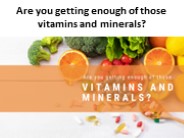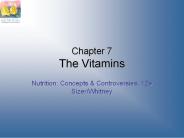Vitamin And Mineral Toxicity Deficiencies PowerPoint PPT Presentations
All Time
Recommended
Minerals & Vitamins Chris Ellason Minerals Macro minerals Ca, P, Na, Cl, Mg, K and S Trace or micro minerals Co, Cu, F, I, Fe, Mn, Mo, Se, Zn Calcium Milk fever ...
| PowerPoint PPT presentation | free to view
A Double-Blind, Randomized, Placebo-Controlled Trial of High-Dose Vitamin D Therapy on Musculoskeletal Pain and Bone Mineral Density in Anastrozole-Treated Breast ...
| PowerPoint PPT presentation | free to download
Vitamins, Minerals & Water Sodium Savvy The human body requires about 500 mg of sodium per day, while the average American usually ingests between 2,300-6,900 mg each ...
| PowerPoint PPT presentation | free to view
Chapter 12 Vitamin and Mineral Replacement Vitamins Organic chemicals necessary for normal metabolic functions, tissue growth & healing Body needs only a small amt ...
| PowerPoint PPT presentation | free to download
The Vitamins, Minerals, & Water: A Functional Approach Chapter 7 Turning Back the Clock Discovery that diseases could be caused by dietary deficiencies Scurvy Rickets ...
| PowerPoint PPT presentation | free to view
PowerPoint Presentation
| PowerPoint PPT presentation | free to download
Vitamins and Minerals General Concepts Divided into two major groups: fat soluble and water soluble fat soluble: A, D, E, K most of the 15 shown as essential for fish ...
| PowerPoint PPT presentation | free to view
VITAMIN AND MINERAL SUPPLEMENTATION DURING PREGNANCY
| PowerPoint PPT presentation | free to download
Through exposure to sunlight and in fortified milk. ... you think about the trend to fortify many food products with vitamins and minerals? ...
| PowerPoint PPT presentation | free to view
Vitamins and minerals are organic compounds used in very small amounts by our bodies for various metabolic processes. They help in keeping our bodies healthy and to function properly. Mostly we get the vitamins and minerals through our diet. However, consuming them in the right amount is essential as they can lead to toxicity if consumed in large amounts and can cause deficiency diseases if the body runs short of them. They can help with B12 deficiency treatment, iron deficiency treatment and many others.
| PowerPoint PPT presentation | free to download
Vitamins and minerals are organic compounds used in very small amounts by our bodies for various metabolic processes. They help in keeping our bodies healthy and to function properly.
| PowerPoint PPT presentation | free to download
Functional Foods By Melissa Bess, Nutrition and Health Education Specialist ... It also present in egg yolk, meat, liver, cheese and dairy products.
| PowerPoint PPT presentation | free to download
Chapter 8: Vitamins and Minerals Define the Following Terms: 1. antioxidants substances that protect body cells and the immune system from damage by harmful ...
| PowerPoint PPT presentation | free to view
Vitamins and Minerals PowerPoint originally prepared by Shanta Adeeb The Nature of Vitamins Vitamins are organic (carbon) compounds needed for normal function, growth ...
| PowerPoint PPT presentation | free to view
Give examples of clinically important scientifically supported indications for supplements ... that vitamin E and other antioxidants are 'dangerous' is likely specious ...
| PowerPoint PPT presentation | free to view
By having a very low fat or fat free diet could cause fat-soluble vitamin insufficiency. ... Take an additional 400 micrograms / day - 400 from pills - 400 from diet ...
| PowerPoint PPT presentation | free to view
VITAMINS AND MINERALS: WHAT, WHEN AND HOW MUCH TO SUPPLEMENT Elin Zander, RD, CD, CNSD If the patient s duodenum was removed as part of the bariatric surgery, which ...
| PowerPoint PPT presentation | free to view
Use of Multiple Micronutrients (Minerals and Vitamins) Preparations (Introduction) U.Tserendolgor MD,Ph.D, Sc.D NRC, PHI ...
| PowerPoint PPT presentation | free to download
Attainment and Maintenance of Nutritional Vitamin D Status: Health Implications ... Bruce W. Hollis, Ph.D. Medical University of ... LPS, mannose and scavenger ...
| PowerPoint PPT presentation | free to view
Approximately 10% of calcium absorbed with vitamin D deficiency ... Nutrient deficiencies involve both macronutrients and vitamins and minerals ...
| PowerPoint PPT presentation | free to view
Readily exreted by the kidney when surpassing the renal threshold - toxicity is rare ... hypercalcemia with hypercalciuria (!stones), bone demineralization. Vitamin E ...
| PowerPoint PPT presentation | free to view
VITAMINS Wendy Matte Stephanee Potts Jennifer Sulak Allie Walker Presentation for HORT 201 Spring 2001 Quiz Do You Need a Multivitamin/Mineral Supplement?
| PowerPoint PPT presentation | free to view
Vitamins Jana Novotn Charles Univ., 2nd Med. Sch. Dept. of Biochemistry
| PowerPoint PPT presentation | free to download
Title: The Differentiation of Mesenchymal Stem Cell Derived from the Human Umbilical Cord Blood into Hepatocyte like cells (Halfawy et al., ) Author
| PowerPoint PPT presentation | free to view
chapter 7 vitamins * * food sources = liver, egg yolk, butter, cream, milk fat, betacarotene = dark green, leafy vegetables (kale, collard greens, spinach ...
| PowerPoint PPT presentation | free to view
Some may be synthesized by the body using precursors or 'Pro-Vitamins' ... Most vitamins originate from plant sources (except B12) as byproducts of photosynthesis. ...
| PowerPoint PPT presentation | free to view
Vitamin & Mineral Deficiency: A Global Progress Report. UNICEF, 2004 ... Vitamin A deficiency. 40% of children 5yrs with mild to severe deficiency ...
| PowerPoint PPT presentation | free to view
Chapter 7 The Vitamins Nutrition: Concepts & Controversies, 12e Sizer/Whitney Vitamin C Toxicity Safe doses Recommendations Tobacco use Physical stressors Food ...
| PowerPoint PPT presentation | free to download
One year supply in fat and liver of most people: So deficiencies are rare ... infants under 3.5 pounds, people unable to absorb fat or metabolize fat properly ...
| PowerPoint PPT presentation | free to view
Vitamin D (Calciferol, Cholecalciferol, Ergocalciferol) ... Vitamin K (Phytonadione) Functions: Blood clotting. Deficiency: Prolonged blood clotting time ...
| PowerPoint PPT presentation | free to view
minerals make up about 4 to 5% of body weight (for a 70 kg individual: 2.8 kg) ... normally given IM (painful) Z-track minimizes tatoo ...
| PowerPoint PPT presentation | free to view
Provitamins are compounds that are not vitamins, but the body can convert them ... Coenzyme : a nonprotein compound that combines with an inactive enzyme to form ...
| PowerPoint PPT presentation | free to view
TUMS Azin Nowrouzi, PhD Vitamin classification Fat-soluble Vitamins Absorbed with dietary fat in small intestine 40-90% absorption efficiency Absorption typically ...
| PowerPoint PPT presentation | free to view
Leafy green vegetables, milk. K. Polyunsaturated plant oils, leafy green ... carotene form found in yellow, orange and dark leafy green vegetables and fruits ...
| PowerPoint PPT presentation | free to view
Vitamin Requirements Daily Values (DV): standard nutrient intake values developed by FDA Includes DRIs (Daily Recommended Intakes for Individuals) and (DRVs) Daily ...
| PowerPoint PPT presentation | free to download
Vitamins A, D, E and K - Chemistry, functions, requirement, sources, deficiency and excess
| PowerPoint PPT presentation | free to download
One of the first signs of Vitamin A deficiency ... Vitamin D deficiency. Rickets ... Vitamin D and the elderly. Deficiencies more likely to develop in elderly ...
| PowerPoint PPT presentation | free to view
The Minerals * * * * * * * * * * * * * * * * * * * * * * * * * Figure 12.15: Bioavailability of Calcium from Selected Foods ...
| PowerPoint PPT presentation | free to download
Unit 1 Chapter 5 Mineral Nutrition Mineral nutrition Mineral nutrients are elements such as N, P, K that plants acquire primarily in the form of inorganic ions from ...
| PowerPoint PPT presentation | free to view
Selenium - Se. Role antioxidant protective of Vit. E. Deficiency Keshan's Disease ... Selenium and Cancer ... Selenium Intakes U.S. soil abundant ...
| PowerPoint PPT presentation | free to view
The Importance of Minerals Agricultural Education Standards: AS 11/12.3-5 Determine the sources and use of nutrients. AS 11/12.3-6 Identify vitamins, minerals and ...
| PowerPoint PPT presentation | free to view
Chapter 8 Vitamins What are Vitamins? Essential organic substances Produce deficiency symptoms when missing from diet Yield no energy Basic functions Facilitate ...
| PowerPoint PPT presentation | free to view
Other interesting facts: Found in the fatty parts of food ... Strawberries, melon. Vegetables. Tomatoes, dark green leafy vegetables, potatoes, broccoli...
| PowerPoint PPT presentation | free to view
Water soluble Vitamins Chapter 8
| PowerPoint PPT presentation | free to download
Body can survive weeks of consuming foods that lack these vitamins. Excess vitamins A and D from supplements can easily reach toxic levels? ...
| PowerPoint PPT presentation | free to view
The Vitamins Vitamin E Chemical nature: A type of tocopherol 4 forms Alpha, beta, gamma, delta Alpha-tocopherol is the most active form Other forms have very limited ...
| PowerPoint PPT presentation | free to view
The Importance of Minerals Agricultural Education Standards: AS 11/12.3-5 Determine the sources and use of nutrients. AS 11/12.3-6 Identify vitamins, minerals and ...
| PowerPoint PPT presentation | free to view
Title: The Vitamins Author: Susan Baker Last modified by: Susan Baker Created Date: 4/12/2004 5:48:16 PM Document presentation format: On-screen Show
| PowerPoint PPT presentation | free to view
Minerals: Key Concepts Minerals are single atoms that cannot be created or destroyed by any ordinary means These single atoms usually carry a charge, which makes them ...
| PowerPoint PPT presentation | free to view
Title: PowerPoint Presentation Author: NUhu Last modified by: Mashal Almutairi Created Date: 1/1/1601 12:00:00 AM Document presentation format: On-screen Show (4:3)
| PowerPoint PPT presentation | free to download
LipidSoluble Vitamins
| PowerPoint PPT presentation | free to view
Water soluble Vitamins Chapter 7 ...
| PowerPoint PPT presentation | free to download
... of iron (protects it from oxidation) tip: take vitamins with orange juice ... Folic acid and other B vitamins help break down homocysteine in the body ...
| PowerPoint PPT presentation | free to view
Vitamins ... between 14 20 substances have been identified as vitamins. many vitamins act as cofactors, coenzymes or prosthetic groups for enzymes ...
| PowerPoint PPT presentation | free to view
Iron, zinc, iodine, selenium, copper, manganese, fluoride, chromium, molybdenum. 2 ... Chromium. AI. Men: 35 micrograms/day. Women: 25 micrograms/day. Chief ...
| PowerPoint PPT presentation | free to view
























































